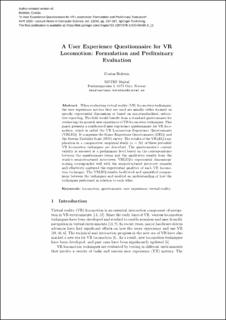| dc.contributor.author | Boletsis, Costas | |
| dc.date.accessioned | 2021-01-12T13:01:09Z | |
| dc.date.available | 2021-01-12T13:01:09Z | |
| dc.date.created | 2020-09-08T12:55:10Z | |
| dc.date.issued | 2020 | |
| dc.identifier.citation | Lecture Notes in Computer Science (LNCS). 2020, 12242 157-167. | en_US |
| dc.identifier.issn | 0302-9743 | |
| dc.identifier.uri | https://hdl.handle.net/11250/2722563 | |
| dc.description.abstract | When evaluating virtual reality (VR) locomotion techniques, the user experience metrics that are used are usually either focused on specific experiential dimensions or based on non-standardised, subjective reporting. The field would benefit from a standard questionnaire for evaluating the general user experience of VR locomotion techniques. This paper presents a synthesised user experience questionnaire for VR locomotion, which is called the VR Locomotion Experience Questionnaire (VRLEQ). It comprises the Game Experience Questionnaire (GEQ) and the System Usability Scale (SUS) survey. The results of the VRLEQ’s application in a comparative, empirical study (n=26) of three prevalent VR locomotion techniques are described. The questionnaire’s content validity is assessed at a preliminary level based on the correspondence between the questionnaire items and the qualitative results from the study’s semi-structured interviews. VRLEQ’s experiential dimensions’ scoring corresponded well with the semi-structured interview remarks and effectively captured the experiential qualities of each VR locomotion technique. The VRLEQ results facilitated and quantified comparisons between the techniques and enabled an understanding of how the techniques performed in relation to each other. | en_US |
| dc.language.iso | eng | en_US |
| dc.publisher | Springer Verlag | en_US |
| dc.subject | Virtuell virkelighet | en_US |
| dc.subject | Virtual reality | en_US |
| dc.subject | Forskningsmetodikk | en_US |
| dc.subject | Research methods | en_US |
| dc.title | A User Experience Questionnaire for VR Locomotion: Formulation and Preliminary Evaluation | en_US |
| dc.type | Peer reviewed | en_US |
| dc.type | Journal article | en_US |
| dc.description.version | acceptedVersion | en_US |
| dc.rights.holder | This is a post-peer-review, pre-copyedit version of an article published in Lecture Notes in Computer Science (LNCS) ( ISSN 0302-9743). The final authenticated version is available online at: http://dx.doi.org/10.1007/978-3-030-58465-8_11. | en_US |
| dc.subject.nsi | VDP::Datateknologi: 551 | en_US |
| dc.subject.nsi | VDP::Computer technology: 551 | en_US |
| dc.subject.nsi | VDP::Datateknologi: 551 | en_US |
| dc.subject.nsi | VDP::Computer technology: 551 | en_US |
| dc.source.pagenumber | 157-167 | en_US |
| dc.source.volume | 12242 | en_US |
| dc.source.journal | Lecture Notes in Computer Science (LNCS) | en_US |
| dc.identifier.doi | 10.1007/978-3-030-58465-8_11 | |
| dc.identifier.cristin | 1828094 | |
| cristin.ispublished | true | |
| cristin.fulltext | postprint | |
| cristin.qualitycode | 1 | |
